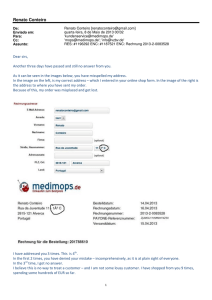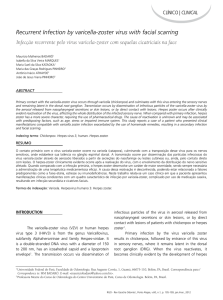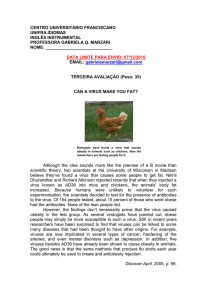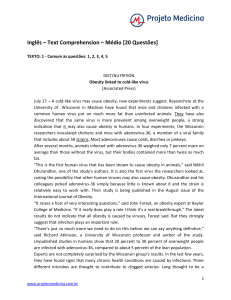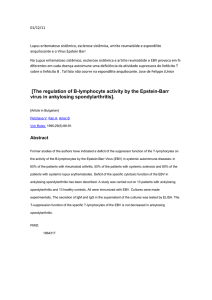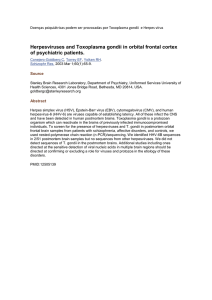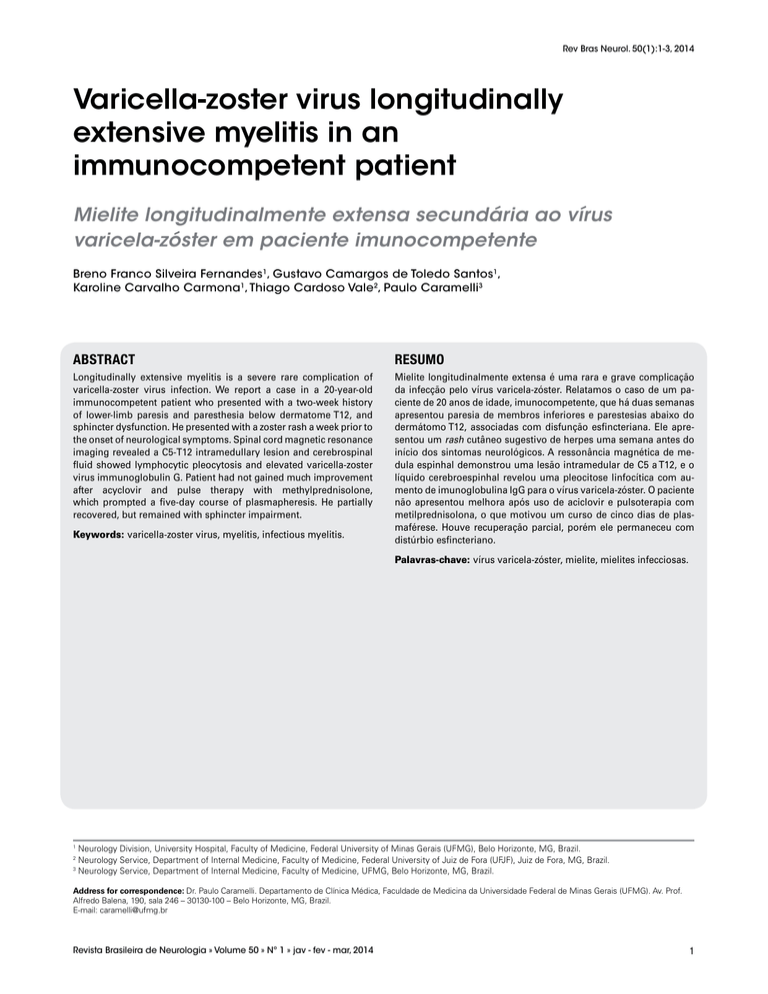
Rev Bras Neurol. 50(1):1-3, 2014
Varicella-zoster virus longitudinally
extensive myelitis in an
immunocompetent patient
Mielite longitudinalmente extensa secundária ao vírus
varicela-zóster em paciente imunocompetente
Breno Franco Silveira Fernandes1, Gustavo Camargos de Toledo Santos1,
Karoline Carvalho Carmona1, Thiago Cardoso Vale2, Paulo Caramelli3
ABSTRACT
RESUMO
Longitudinally extensive myelitis is a severe rare complication of
varicella-zoster virus infection. We report a case in a 20-year-old
immunocompetent patient who presented with a two-week history
of lower-limb paresis and paresthesia below dermatome T12, and
sphincter dysfunction. He presented with a zoster rash a week prior to
the onset of neurological symptoms. Spinal cord magnetic resonance
imaging revealed a C5-T12 intramedullary lesion and cerebrospinal
fluid showed lymphocytic pleocytosis and elevated varicella-zoster
virus immunoglobulin G. Patient had not gained much improvement
after acyclovir and pulse therapy with methylprednisolone,
which prompted a five-day course of plasmapheresis. He partially
recovered, but remained with sphincter impairment.
Mielite longitudinalmente extensa é uma rara e grave complicação
da infecção pelo vírus varicela-zóster. Relatamos o caso de um paciente de 20 anos de idade, imunocompetente, que há duas semanas
apresentou paresia de membros inferiores e parestesias abaixo do
dermátomo T12, associadas com disfunção esfincteriana. Ele apresentou um rash cutâneo sugestivo de herpes uma semana antes do
início dos sintomas neurológicos. A ressonância magnética de medula espinhal demonstrou uma lesão intramedular de C5 a T12, e o
líquido cerebroespinhal revelou uma pleocitose linfocítica com aumento de imunoglobulina IgG para o vírus varicela-zóster. O paciente
não apresentou melhora após uso de aciclovir e pulsoterapia com
metilprednisolona, o que motivou um curso de cinco dias de plasmaférese. Houve recuperação parcial, porém ele permaneceu com
distúrbio esfincteriano.
Keywords: varicella-zoster virus, myelitis, infectious myelitis.
Palavras-chave: vírus varicela-zóster, mielite, mielites infecciosas.
1
2
3
Neurology Division, University Hospital, Faculty of Medicine, Federal University of Minas Gerais (UFMG), Belo Horizonte, MG, Brazil.
Neurology Service, Department of Internal Medicine, Faculty of Medicine, Federal University of Juiz de Fora (UFJF), Juiz de Fora, MG, Brazil.
Neurology Service, Department of Internal Medicine, Faculty of Medicine, UFMG, Belo Horizonte, MG, Brazil.
Address for correspondence: Dr. Paulo Caramelli. Departamento de Clínica Médica, Faculdade de Medicina da Universidade Federal de Minas Gerais (UFMG). Av. Prof.
Alfredo Balena, 190, sala 246 – 30130-100 – Belo Horizonte, MG, Brazil.
E-mail: [email protected]
Revista Brasileira de Neurologia » Volume 50 » Nº 1 » jav - fev - mar, 2014
1
Fernandes BFS et al.
INTRODUCTION
Varicella-zoster virus (VZV) reactivation from
latently infected ganglia causes multiple neurologic
diseases. The most common is herpes zoster, which
is frequently complicated by postherpetic neuralgia,
meningoencephalitis and vasculopathy, including
VZV temporal arteritis and retinal necrosis. VZV
can spread centrally to the spinal cord to cause
myelitis from frank invasion of virus or to produce
spinal cord infarction1. VZV myelitis usually presents
with weakness and abnormal deep tendon reflexes
that are most prominent ipsilateral to the rash. The
motor dysfunction may remain ipsilaterally localized
as segmental paresis or spread to the contralateral
cord, causing paraparesis. Sensory findings also
are frequent and bladder dysfunction may be seen.
The myelitis can occur in immunocompetent
patients, although it is most commonly related to
immunocompromised states2. We report a case
of a longitudinally extensive myelitis due to VZV
infection in an immunocompetent patient, which is
very rarely seen in the literature.
rate, C-reactive protein, antiphospholipid antibody
panel, antinuclear factor and anti-DNA antibodies,
anti-SSA and anti-SSB antibodies, c-ANCA and
p-ANCA, rheumatoid factor, anti-cardiolipin
antibodies, C3 and C4 complement, vitamin B12,
folic acid, hepatitis B and C, lupus anticoagulant,
thyroid stimulating hormone and anti-aquaporin
4 antibody. Serum HIV and HTLV were negative.
IgG and IgM Lyme and herpes simplex serologies
were negative. Thoracic and abdominal computed
tomography was unrevealing as well as upper
gastrointestinal endoscopy, testis and abdominal
ultrasounds, carcinoembryonic and other cancer
antigens (CA 19.9, CA 15.3 and CA 125). He was
treated with methylprednisolone (1g/day) followed
by oral steroids (60 mg/day) and acyclovir (10 mg/
kg TID for 14 days). Patient had not gained much
improvement after pulse therapy what prompted
a five-day course of plasmapheresis. He achieved a
grade 4+ MRC muscle strength improvement and
partial recovery of paresthesia, but remained with
impairment of sphincter.
CASE PRESENTATION
DISCUSSION
A 20-year-old previously healthy Brazilian man
presented with a two-week history of lower-limb
paresthesia that progressively worsened and involved
all dermatomes below T12. He evolved with lowerlimb weakness, ascending paresthesia, urinary
retention and fecal incontinence. Neurological
examination showed a T5 sensitive level and lowerlimb paraparesis (grade 3 MRC muscle strength).
The patient had developed a zoster rash a week prior
to the onset of neurological symptoms, and presented
to our unit with clustered dermatome crusted vesicles
and later developed another suggestive rash during
steroid use. Brain magnetic resonance imaging (MRI)
was normal and spinal cord MRI revealed a C5-T12
intramedullary lesion (Figure 1). Cerebrospinal
fluid (CSF) showed lymphocytic pleocytosis (200
cells/uL) and elevated VZV immunoglobulin G
(0.95; reference values of < 0.1). CSF venereal
disease research laboratory, polymerase chain
reaction (PCR) for VZV and herpes simplex virus,
bacteria, mycobacteria and fungi cultures were
negative. Laboratory tests included normal levels
of blood biochemistry, erythrocyte sedimentation
Diagnosis of VZV myelitis is based on clinical and
radiological features and is supported by the detection
of VZV DNA PCR or the production of VZV IgG in
the CSF. The VZV IgG index is a quotient expressed
as CSF antibody titer/serum antibody titer/CSF
total IgG/serum total IgG. A high quotient value
provides evidence of intrathecal production of
anti-VZV antibody. Our patient had an extremely
elevated index, making very improbable that the
immunoglobulin had been produced outside the
thecal space and crossed the blood-brain barrier1,2.
To the best of our knowledge, longitudinally
extensive VZV myelitis has only been reported once in
Japan3. However, the authors reported a longitudinally
disseminated spinal cord involvement, which is
different from the contiguously extensive lesion of
our case, mimicking the neuroimaging features of
neuromyelitis optica spectrum disorder (NMOSD).
In our case, NMOSD was not the primary diagnostic
consideration because of the inflammatory pattern of
the CSF. A recent paper described the CSF profile in
211 lumbar punctures of 84 patients with NMOSD.
A CSF pleocytosis greater than 100 leucocytes/μL
2
Revista Brasileira de Neurologia » Volume 50 » Nº 1 » jav - fev - mar, 2014
Varicella-zoster and myelitis
A
B
C
Figure 1. Magnetic resonance imaging (MRI) of the lesion. (A) Sagittal T2-weighted cervical spinal cord MRI showing an extensive intramedullary lesion
ranging from C5 to T3 vertebral levels. (B) Sagittal T2-weighted thoracic spinal cord MRI showing a longitudinally extensive and continuous intramedullary
lesion of the entire thoracic cord. (C) Axial T2-weighted C6 spinal cord MRI showing intramedullary centrally-located hyperintense lesion in a H-shaped
pattern.
was observed only in 6.2% of the samples and
an even smaller percentage had greater than 200
leucocytes/μL count4. Another interesting feature of
our case is that the extensive involvement occurred in
an otherwise healthy patient and in whom neoplastic
and immunodeficiency states were ruled out.
CONFLICT OF INTEREST
We declare no conflicts of interest/no financial
support. Patient has consented with the publication
of this manuscript.
REFERENCES
CONCLUSION
1. Nagel MA, Gilden D. The challenging patient with varicella-zoster
virus disease. Neurol Clin Pract. 2013;3:109-16.
VZV infection must be included in the differential
diagnosis of longitudinally extensive myelitis, particularly of neuromyelitis optica and NMOSD. Physicians should bear in mind that immunocompetent
patients can also present with VZV infection and a
severe and extensive spinal cord involvement.
2. Amlie-Lefond C, Jubelt B. Neurologic manifestations of varicella
zoster virus infections. Curr Neurol Neurosci Rep. 2009;9:430-4.
Revista Brasileira de Neurologia » Volume 50 » Nº 1 » jav - fev - mar, 2014
3
3. Tajima Y, Mito Y. Longitudinally disseminated spinal cord lesions
(moth-eaten appearance) in varicella-zoster myelitis. Intern Med.
2011;50:2059-60.
4. Jarius S, Paul F, Franciotta D, et al. Cerebrospinal fluid findings in
aquaporin-4 antibody positive neuromyelitis optica: results from
211 lumbar punctures. J Neurol Sci. 2011;306:82-90.

